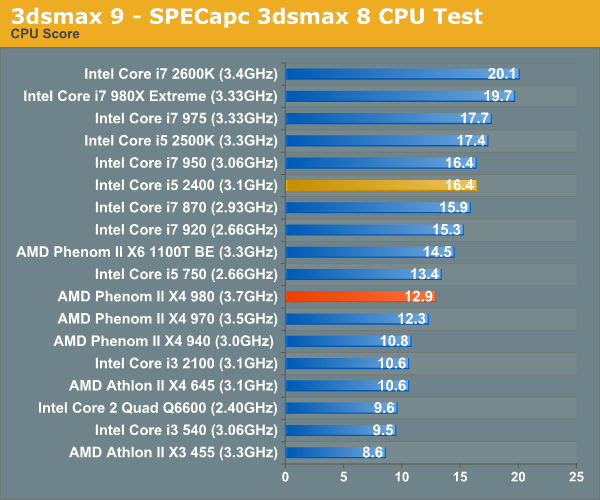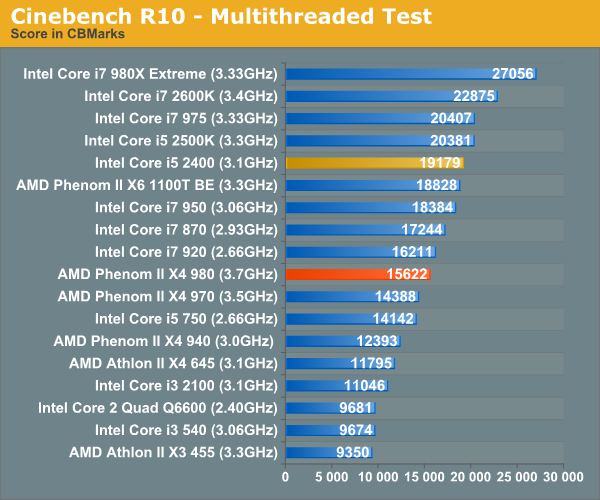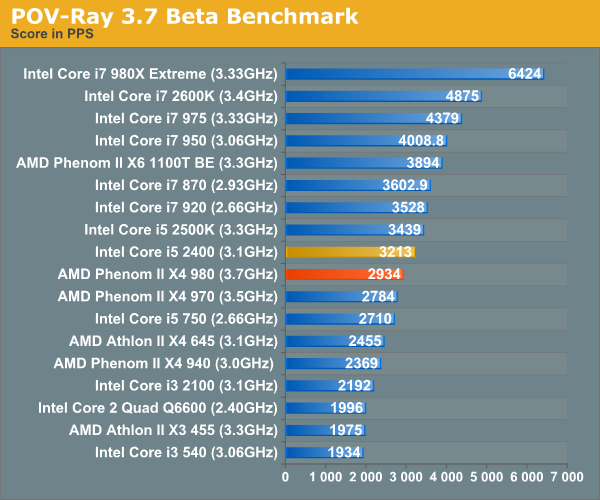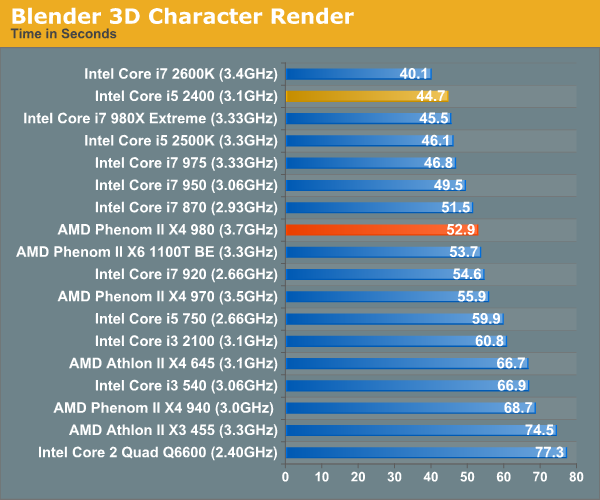AMD Phenom II X4 980 Black Edition Review
by Anand Lal Shimpi on May 2, 2011 10:42 PM EST3D Rendering Performance
Today's desktop processors are more than fast enough to do professional level 3D rendering at home. To look at performance under 3dsmax we ran the SPECapc 3dsmax 8 benchmark (only the CPU rendering tests) under 3dsmax 9 SP1. The results reported are the rendering composite scores.

Created by the Cinema 4D folks we have Cinebench, a popular 3D rendering benchmark that gives us both single and multi-threaded 3D rendering results.


POV-Ray is a popular, open-source raytracing application that also doubles as a great tool to measure CPU floating point performance.
I ran the SMP benchmark in beta 23 of POV-Ray 3.73. The numbers reported are the final score in pixels per second.












78 Comments
View All Comments
rfle500 - Tuesday, May 3, 2011 - link
I'm glad to see a compile test in the lineup. Can I ask - how did you choose number of threads for the test - was it the same for all (12) or based on number of physical, or hyperthreaded cores. In my experience, on AMD chips most compilations are faster with overloaded threads, say 2x number of physical cores - did you test this possibility?silverblue - Thursday, May 5, 2011 - link
Some programs don't work well with non-power-of-2 architectures either, which would harm performance of the X3 and X6 processors (Windows Media Encoder 9), or even worse, cripple things completely (DivX or XviD on VirtualDub uses just one of an X3's cores, so you need to set the affinity to two cores). I suppose logically, overstressing a hyperthreaded CPU would mean that the its execution units are fully utilised and, as such, logical cores won't actually make any difference, so it would be in these situations where the X6 could perhaps close the gap a little.Shadowmaster625 - Tuesday, May 3, 2011 - link
It also gives them an opportunity to remove millions of wasted cpu cycles.krumme - Tuesday, May 3, 2011 - link
Man this is some boring news. I would prefer to get some more inside or backgroud info from AMD, Intel or Arm country, even if it takes years compared to this. But i guess this is better business :)greenguy - Tuesday, May 3, 2011 - link
I keep checking here looking for the inevitable Llano review, but it's not here yet. How long do we have to wait?Action_Parsnip - Tuesday, May 3, 2011 - link
It appears you would like to marry Francois Piednoel?jabber - Wednesday, May 4, 2011 - link
Who is Francois Pedofile?Never heard of him.
529th - Tuesday, May 3, 2011 - link
I don't see this mentioned in the review nor the benchmarks, someone correct me if I am wrong but when those benches are made, are they made with Turbo disabled? If not, I don't see it as a fair comparison if you are running stock speeds when comparing a 3.3Ghz i7 2500K vs a 3.33Ghz i7 975 You have games that make use of all cores, and some that use only a few.. so you may get a higher turbo on a Sandy Bridge chip. This is not exact science but making the GHz speed into an exact comparison without Turbo enabled gives a little more insight into the product..just sayin
PubFiction - Tuesday, May 3, 2011 - link
This is just a final release to cap off Phenom 2 they know they were beat they are just giving a little speed boost to it for more value. If this was bulldozer then ya it would be bad but we already know what phenom 2 has to offer why is there so much discussion around a final revision chip. They are just throwing out what may be the most speed they can with that core until BD arrives.Casper42 - Wednesday, May 4, 2011 - link
"AMD originally introduced the Phenom II architecture over two years ago to compete with Intel's Core 2 lineup. Intel has since been through one major microarchitecture revision (Sandy Bridge) and Phenom II is beginning to show its age."Am I missing something or just not counting properly.
Phenom II introduced to compete with Core 2
Intel then Introduces Nehalem/Westmere
Intel then Introduces Sandy Bridge
So wouldn't Intel have been through 2 major architecture revisions?